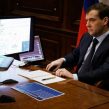
Russian President Medvedev Submits Draft Treaty on European Security Architecture
Publication: Eurasia Daily Monitor Volume: 6 Issue: 224
By:

Article 4 of Medvedev’s draft treaty (full text on Russia’s presidential website, www.kremlin.ru, November 30) would create mechanisms to “examine differences and disputes that may arise over this treaty’s interpretation and implementation.” The proposed mechanisms would operate on three levels: first, consultations in variable formats among treaty participants (states and international security organizations such as NATO, EU, OSCE, CSTO); second, the fully-fledged conference of treaty participants; and, third, their extraordinary conference.
This multi-format concept is designed to counterbalance, supplant, and splinter NATO’s own formats, including the North Atlantic Council (NAC) and Euro-Atlantic Partnership Council (EAPC), with regard to debate and decision-making on topical security issues in the NATO area and its immediate eastern neighborhood.
Any treaty participant could “initiate consultations with one or more participants, if the initiating participant deems that a violation or threat of violation of this treaty’s provisions has occurred or is imminent, or if it deems necessary to raise any issue related to this treaty’s contents.” In that case, the initiating participant may “address any treaty participant(s), whom it deems interested in examining that issue, with proposals to hold consultations” (Article 5).
Furthermore, any participant in consultations may subsequently propose holding a fully-fledged conference [presumably, if the consultations turn out to be inconclusive]. The conference shall be deemed legally constituted if at least two thirds of all treaty participants attend this forum. The conference shall operate under its own rules of procedure. Its decisions shall be “taken by consensus and binding” (Article 6).
A treaty participant that has been the object of an armed attack or is threatened with such an attack can call for an “extraordinary conference, to be held immediately for determining the necessary collective measures.” The extraordinary conference shall also operate under its own rules of procedure. This forum shall be deemed legally constituted if at least four or five treaty participants [the number seems negotiable in the draft] attend. The extraordinary conference’s decisions shall be “taken by unanimity and binding” (Article 8).
Articles 5, 6, and 8 of the draft treaty would wreak havoc on NATO’s own decision-making processes and its procedures by grouping allied countries with Russia and its loyalists in some ad-hoc, unpredictable, arbitrarily created forums. This would result in parallel structures and potentially conflicting decisions. These articles are a prescription for chaos in NATO and instability in the NATO area and neighborhood.
By seeking to promote such fragmentation, Medvedev’s draft unwittingly exposes the real meaning of Russia’s concept of “indivisible Euro-Atlantic and Eurasian security.” That concept is intended to justify Russia’s intrusion into NATO’s decision-making processes while at the same time maintaining a Russian-led Eurasian bloc and potential sphere of influence.
Moreover, article 8 seems custom-made for Russia to initiate or threaten military action under a CSTO flag of convenience. This is why Medvedev wants to empower an “extraordinary conference” of even “four or five” countries to authorize collective defense measures against an attack or threat of attack on a member country. Moscow would be delighted to receive a stamp of approval for CSTO-flagged actions from a NATO-approved forum, in the unlikely event that NATO accepts Medvedev’s proposal.
Under Medvedev’s article 7, “A treaty participant is entitled to regard an armed attack on another participant as an attack on itself;” and “it has the right to provide the necessary assistance, including military, before such time as the United Nations Security Council takes the necessary measures.”
The implications are at least threefold. First, this procedure can justify a purely unilateral Russian military intervention, outside the CSTO’s nominal umbrella. Secondly, such intervention could pre-empt a decision by the “extraordinary conference” envisaged in article 8. Thus, Moscow claims a right to having its cake and eating it too, in terms of military intervention. And, thirdly, Moscow would breezily bypass the UN Security Council, even as it wants to hold the United States and others accountable to that same body.
Under the draft treaty’s article 9, “Treaty participants confirm that their obligations, stemming from other international security agreements, do not contradict the present treaty. The treaty participants shall not undertake international obligations incompatible with the present treaty.”
This formulation reverses entirely the standard clause whereby signatories to a new treaty declare that it does not prejudice their pre-existing commitments. Instead, Russia would stipulate that previous obligations should not contradict the new treaty. Thus, the Medvedev-proposed treaty would supersede NATO commitments (presumably including even Article Five) in Moscow’s interpretation. And it would also preclude future decisions that Moscow would deem “incompatible” with Medvedev’s treaty.
Medvedev’s draft treaty focuses overwhelmingly on issues of process and procedure, rather than substance. As such, it seeks to disorganize and fragment the NATO alliance, insert Moscow into NATO’s decision-making arrangements, and build a Russian sphere of predominant influence at the same time. All this could be seen as carrying NATO’s passive consent, if Medvedev’s document gains acceptance even as a basis for further discussions between Russia and NATO.




